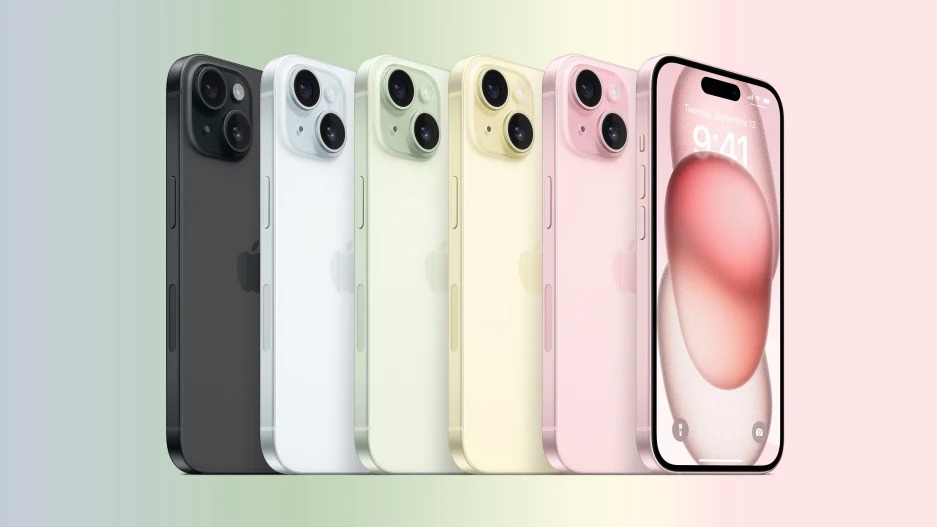- | 8:00 am
The new iPhone’s muted colors mark the end of tech’s bright era
Last year’s model made a splash with purple and bright hues. This year’s is a still pond of pragmatic pales.

The new iPhone is out, and it can only be described in one word: pale.
Revealed to the public today at Apple’s latest release event, the iPhone 15 was instantly notable for the lack of saturated color in its shell. In contrast to previous models that embraced bright, even loud colors like red and yellow, the new selection of iPhones is available in a faint pastel palette of blue, yellow, off-white, and pink, plus the basic techcore black. Seen together, the color options appear to be barely differentiated shades. Seen alone, their embedded color tints almost fade to white. The iPhone 15 Pro is even more restrained, coming in four shades of titanium metal that are similarly indistinguishable.
It could be a sign of the gradual decoloring of consumer electronics. Or it could be a bet from one of the biggest tech companies in the world that, actually, bright color is not what people want. Most probably, though, it’s a tacit admission that, despite the flashy imagery and fun ads that are made possible by embracing the rainbow, diluting that color reduces the risk that a color will flop while preserving the illusion of choice.

Apple’s event today confirmed suspicions that bright colors are on the way out. Photos leaked in late August revealed the toned-down color palette of the iPhone 15, which is a notable zag from the bright array of color choices shown the last time Apple revealed new iPhones, in September 2022. The presenter, Kaiann Drance, highlighted the phone’s five “gorgeous colors,” including “a strikingly elegant purple.”
The dimming of the iPhone 15 may simply be a black-and-white business decision about inventory handling, according to Josh Lowitz, co-founder of Consumer Intelligence Research Partners (CIRP), which does industry research on Apple and Amazon. “I think there’s an incentive to narrow the color choices just from a SKU [stock keeping unit] management point of view,” he says. “If you do the math, it’s like six or seven models across three or four storage capacities across three to six colors. It’s hundreds of options.”
The subdued color range of the new iPhone is also likely a recognition that what tends to sell is the most basic color scheme. “Black is still always at the top and white sort of fights it out with another alternative for second spot,” Lowitz says.
Data backs this up. CIRP published a report in March showing the color breakdown for purchases of five different model classes of iPhones, from 2020’s iPhone 12 through 2022’s iPhone 14 Pro and Pro Max. For every model the varied colors available made up only small minorities compared to the sales of phones in black—that is until the iPhone 14 came out. CIRP’s data shows that a whopping 42% of sales were for phones that were purple.
“For years we’ve asked people what color their phones are because it was always just sort of a novelty question, it was a little interesting, and we thought it made the survey more engaging,” says Lowitz. “Purple is the surprise winner currently.”
That’s probably an outlier, Lowitz says, noting that Apple made a concerted marketing push of its purple iPhone after its release. “These color launches are part of their marketing communications plan but it’s not clear it’s part of their customer demand plan,” Lowitz says. “It’s something to talk about. It’s not clear that it’s something that drives a decision.”
CIRP has data on that as well. In its quarterly surveys, the company asks respondents, in an open-ended question, what drove them to buy their phone. Answers typically mention the camera, the storage capacity, or something being wrong with the customer’s old phone. “I don’t know if we’ve ever had somebody who enters into the open-ended box ‘I loved the color,’” Lowitz says. “It would be weird if they did, let’s be honest.”
And yet colored phones have sold in the past, including the surprisingly successful purple iPhone 14. Bright colors and maximal design are far from dead, but Apple is not alone in dialing things down a bit. Late last year Google released a line of Nest WiFi routers in subtle pastels. Headphones and earbuds from Beats have seen their bright colors limited to just a few popping reds and yellows, while most models tend toward grayscale finishes.
These trends are probably temporary, and likely to change again. Even within Apple, the pendulum has swung wildly, from the candy-colored iMacs of the late 1990s to the rainbow of 2019-era iPhones that broke the company’s years-long pattern of black-gray-white minimalism.
Lowitz says the color availability may also be affected by the changing ways people buy their phones. Compared to the height of the pandemic, fewer customers are now buying their phones online and opting instead to purchase them in physical retail stores. In June 2020 fully half of all iPhone sales happened online. By June 2023, CIRP’s data shows that number has dropped to 35%. “That means people are buying from locations that have narrower inventories,” Lowitz says. That hot purple iPhone may simply not be in stock.
One final factor that may be behind the draining colors of the iPhone is that most iPhones, and most phones in general, end up inside a case that typically hides the color of the phone body within. CIRP data shows that more than 75% of iPhone users keep their phones in cases. “It’s fun to buy a purple phone but you almost certainly put it in a case and nobody knows you have a purple phone anyway,” Lowitz says. “I don’t even know what color the phones are in our house, I only know them by the cases. And I was involved in the purchase of all of them.”







































